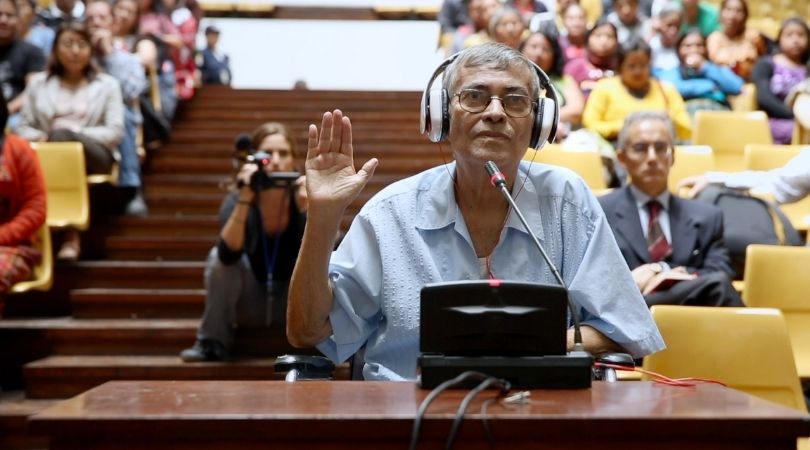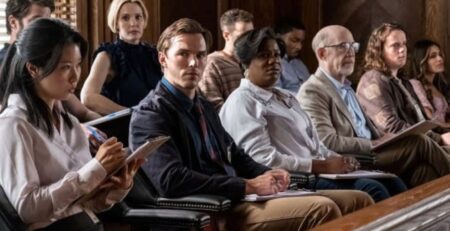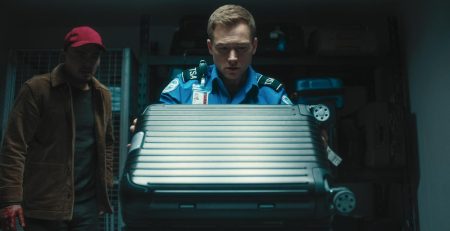
In Guatemala, there is very little film material from the 70s. With the exception of footage preserved thanks to smuggling or recorded by foreigners, everything was destroyed by a military regime trying to hide the traces of its innumerable atrocities and human rights violations. During this stage, however, journalist Elías Barahona managed to infiltrate the government as Press Chief for bloodthirsty Donaldo Álvarez Ruiz, the Interior Minister who orchestrated the murder, torture, and disappearance of countless political opponents. Risking his life and that of his family, Barahona used the shadows to save people, combat the silence imposed by the government, and shed light on its misdeeds. His story is told by Anaïs Taracena in the extraordinary documentary The Silence of the Mole.
Barahona is compared by a friend to the Alice in Wonderland Cheshire cat; although smiling, he knew how to disappear and use silence to his advantage, qualities that made him a perfect spy. However, the film never romanticizes this work as if it were some kind of Hollywood role. Instead, it explores the complexities of his life under fear and in a mandatory state of mistrust for the people around him. In the most haunting piece of footage, we witness as Barahona confirms the existence of death squads encharged to hunt and kill the opposition. He also reveals the prominent role of the United States in the Guatemalan genocide—the training of troops, the formation of paramilitary groups, and the Vietnam-mirroring strategies of psychological warfare used to kill and destroy entire zones. These are just some of the bone-chilling explanations he provides.
In addition to highlighting the heroism of Barahona, the documentary is an invaluable tool to learn about history from the voices of those who lived or studied it long enough. The director assembled the film with the support of interviews with colleagues and relatives of Barahona, with kidnapping survivors and journalists of the time. As a result, no conversation is wasted. Each one is like a brushstroke on a canvas that tries to reveal the history of violence lived in Guatemala. Taracena’s work compiling all these testimonies is exemplary given the enormous fear that still exists around the subject.
The secret weapon of The Silence of the Mole is Taracena’s own narration: calm, confident, and powerful, like a hypnotic whisper in the ear that leads you by the hand through the horrors of war. This element is combined with poetic and disturbing shots of the corridors and offices occupied by Álvarez during his tenure; the lighting gives a creepy quality to things as simple as an armchair to remind us that, sitting in this old piece of furniture, a man ordered the killing of thousands of innocents.
“Blood” is the response of an archivist from the National Cinematheque when questioned about what he remembers about Álvarez. He helps us understand the erasure of filmic testimonies about the massacre. But not everything is lost, as Taracena carries out an outstanding recovery work and shows us lost footage of the time: visual witnesses to the atmosphere of fear and repression.
In 2014, Elías Barahona testified in a trial about the 1980 fire caused by authorities of the Spanish Embassy in which 36 people died. His experience and his testimonies as an infiltrator supported the exercise of justice. Later that day, he spoke with Taracena, and a few weeks later, he passed away. It is as if, before finally being able to rest in peace, he had only been waiting for one last chance to honor his profession as a journalist and, as Taracena seeks to complement with The Silence of the Mole, to open the eyes of a country with fear of a legacy of violence that is still felt in its streets.
In Guatemala, schools and history books do not speak much about what happened in the seventies and eighties. There is still fear and divisions; addressing the issue of war is “politically incorrect.” That is why The Silence of the Mole is such an indispensable cinematographic tool and an example of the power of documentary cinema: it seeks to publicize a dark chapter that many try to forget or even hide, and it does so by highlighting Barahona, a man who had the guts to go where few dared.
The Silence of the Mole was screened as part of DOC NYC 2021.
The Silence of the Mole
-
Rating - 8.5/108.5/10
TL;DR
The Silence of the Mole is such an indispensable cinematographic tool and an example of the power of documentary cinema: it seeks to publicize a dark chapter that many try to forget or even hide, and it does so by highlighting Barahona, a man who had the guts to go where few dared.




